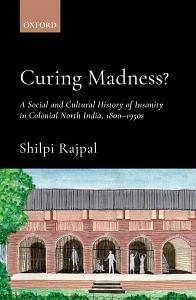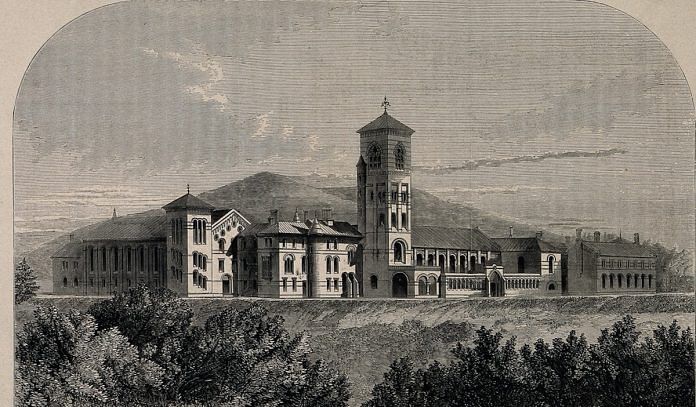Asylums marched along with colonialism in India. Much before the consolidation of imperial power, the incarceration of the insane became a widespread phenomenon. The insane hospitals were initially opened for the sequestration of insane soldiers but soon the provision was extended to the ‘native’ insanes.
The Indian colony was viewed as an exemplary model of codification by the colonizers. This might be true for the other sets of laws such as the criminal code but as far the lunacy laws were concerned, they were more or less British in form and content. In the absence of any set of clear rules or laws related to lunacy in medieval India, the British were free to transport their own laws. As Cohn observes, ‘The laws of these colonies were the laws of Great Britain.’ Indian lunacy laws were heavily influenced by, if not an exact replica of, the English lunacy law.
After the passing of the 1849 Act, the next piece of legislation related to lunacy in India was enacted in 1858. Historians working on the history of psychiatry in India have emphasized that the explicit aim of the 1858 Act was to bring ‘the legal situation in India in line with that of Britain’. However, mention might be made of an incident that occurred in 1856 which pushed the government to pass this historic Act. The Superintendent of Bhowanipore and Dullunda Asylums, T. Cantor, wrote to the secretary of the medical board:
I avail myself of the present occasion to call the attention of the Board to the fact that no Act exists, legalizing, in this Presidency, the admission and detention for treatment in asylums of insane patients. A few days after the asylum had become the property of Government, an instance occurred in which a certain attorney thought proper to discredit my declaration that an insane patient had been discharged to the care of his relations. I was compelled before the Supreme Court to make an affidavit to that effect, and I have been advised that the accidental discharge, only, of the lunatic saved me from legal prosecution. Under such circumstances I am compelled to solicit the Board to obtain protection for my office.
Cantor had handed over William Knox, an inmate of the Bhowanipore Lunatic Asylum, to the latter’s daughter, who undertook to take proper care of him. Following the release of Knox, probably within a day or so, Cantor received a letter from Mr T. Sherrington, an attorney:
I am instructed by a friend of Mr. Knox to make an application to the Supreme Court for his release, he being considered by his friends sufficiently sane to be at liberty and manage the affairs; but previous to taking any measures, I think it is right to enquire of you upon whose authority Mr. Knox was committed to your charge, and under what circumstances and by whom is he detained at the asylum. I will feel obliged by being furnished with this information.
Also read: Norms laid down, but little has been done to rehabilitate people cured of mental illness
Cantor was forced to supply an affidavit certifying that the government of Bengal instructed him to take care of Knox. Cantor felt threatened and demanded legislative immunity. What is worth noting is that it was the absence of relevant legislation that concerned the officials and not the welfare of the subjects. This incident, though minor in nature, led to an extensive debate in official circles. The papers relating to Lunacy Act nos XXXIV, XXXV, and XXXVI found in the NAI give us an insight into the debate that took place in the official circles before the passing of the 1858 Act.
The opinion of the Advocate General was invited on the matter. W. Ritchie, the Advocate General, argued that ‘a law was not of an absolute necessity in the way the superintendent of the Bhowanipore Asylum had argued’. Nevertheless, he was of the view that
it was easy to convince the Supreme Court in the case of Mr. Knox as his lunacy was established, but in cases where lunacy was of subtle nature and one would need the protection of the law [sic]. Giving a background to the general law of lunacy that had existed in India established by the charter of 1773, the crown delegated the responsibilities of a propertied lunatic to the Supreme Court, a reform in the respect is loudly called for.
He felt that recent improvements in English lunacy laws should be brought to India. Ritchie was fixated on the propertied lunatic and management of his/her estate since he averred that ‘in order to obtain the protection of the Court for the person or property of a lunatic, a heavy expense (the very lower being, I understand, fifteen hundred Rupees, and varying from that to three thousand Rupees) must be incurred. Unless, therefore, the lunatic has considerable property, recourse to a court is idle’. It is here that he vociferously demanded a reform. It is in a minor paragraph that Ritchie discussed the necessity of proper provision for the pauper lunatics in India.
The Indian Lunacy Act of 1858, though modelled on the English Lunacy Act of 1853, evaded the issue of pauper lunacy. In England the question of pauper lunacy had come to the fore in the period and the Lunatics Act of 1845 led to the establishment of a permanent National Lunacy Commission in England. The Act made compulsory the setting up of county and borough asylums to house pauper lunatics. The Lunacy Act of 1853 provided for framing of rules related to pauper lunacy and its management. Issues such as how funds could be raised for providing asylums and how expenses for maintenance of lunatics could be met were addressed by the 1853 Act. In England poverty was officially recognized as a problem to be dealt with, but it was not acknowledged as such in the colonies. Early moderate nationalists blamed the colonial state for the creation of widespread poverty in India. What is evident is the fact that the colonial government was washing its hands off any sort of poor relief. The government officials kept on repeating that only ‘dangerous’ lunatics and ‘harmless’ incurables should be kept in the asylums.
The Inspector General of Prisons for the North Western Provinces wrote to the government in this context that ‘the government cannot undertake to provide for all lunatics nor even for all pauper lunatics’. David Arnold has looked at the issue of poverty and state-sponsored poor relief in colonial India. He remarks that ‘the 1837–1838 North Indian famine saw a widespread use of such terms as paupers, vagrants and the able bodied and deserving poor that echo poor law legislation in Britain. But despite this rhetoric, there was extreme reticence about adopting similar measures in India’. This reticence was due to the fact that Indians were regarded as being numerically too many to be given systematic state relief. Arnold notes that ‘private charity was organized to fill the void by the paucity of state relief but in novel forms of provincial and all-India funds’. He states that ‘while poverty and nakedness were universal in India this did not signify the same degree of suffering as in Europe’. He cites as evidence the statement of William Tennant, who was a Calcutta Chaplain: ‘An Hindoo, feels himself comfortable on the same fare on which the Englishmen would languish and starve.’
Also read: At Agra mental health institute, no one forgets to wear mask — even patients with dementia
The 1858 Act became the legal source for the establishment and management of the lunatic asylums in India. The Magistrate, the police, and the Medical Officer played imperative roles in certifying and committing the ‘native’ insane to the asylum. The Act stated that ‘it was the duty of the Darogah or District Police officer to send to the magistrate all persons found wandering at large within his district who were deemed to be lunatics, and all persons believed to be dangerous by the reason of lunacy’. The police was to interpret alleged ‘lunacy’ according to the given situation. The Act indirectly made a distinction between psychiatry for the rich and for the poor. The Superintendent in Charge at the Cuttack Asylum wrote, ‘Lunatics are found by the police disturbing the peace; and unable to take care of themselves, they are at once taken up and brought before the nearest magistrate.’ The ‘wandering’ and ‘dangerous’ lunatics were first sent to a Magistrate, who performed his medical-executive role with the help of the civil surgeon. He identified and certified insanity. After examination, the Magistrate issued orders of dispatch to the nearest jail or asylum.
Another significant aspect of the Indian Lunacy Act of 1858 was the way in which the term ‘lunatic’ was used. The word ‘lunatic’ as used in this Act ‘meant and included every person of unsound mind and incapable of managing his affairs, and every person being an idiot’. The definition of ‘lunacy’ remained vague in this period. It was left to the police and the officials to (mis)construe its meanings.
 This excerpt from ‘Curing Madness? A Social and Cultural History of Insanity in Colonial North India, 1800–1950s’ by Shilpi Rajpal has been published with permission from Oxford University Press.
This excerpt from ‘Curing Madness? A Social and Cultural History of Insanity in Colonial North India, 1800–1950s’ by Shilpi Rajpal has been published with permission from Oxford University Press.



